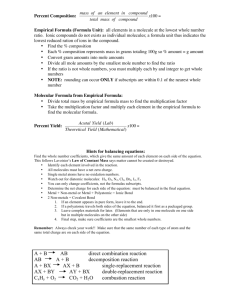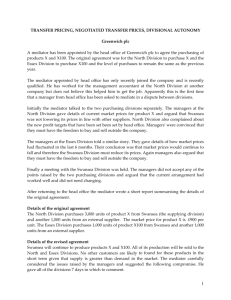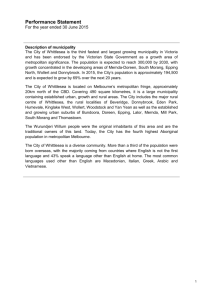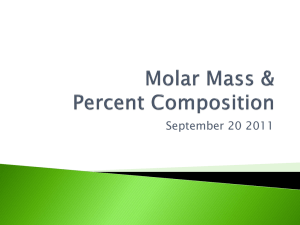X100 Introduction to Business
advertisement
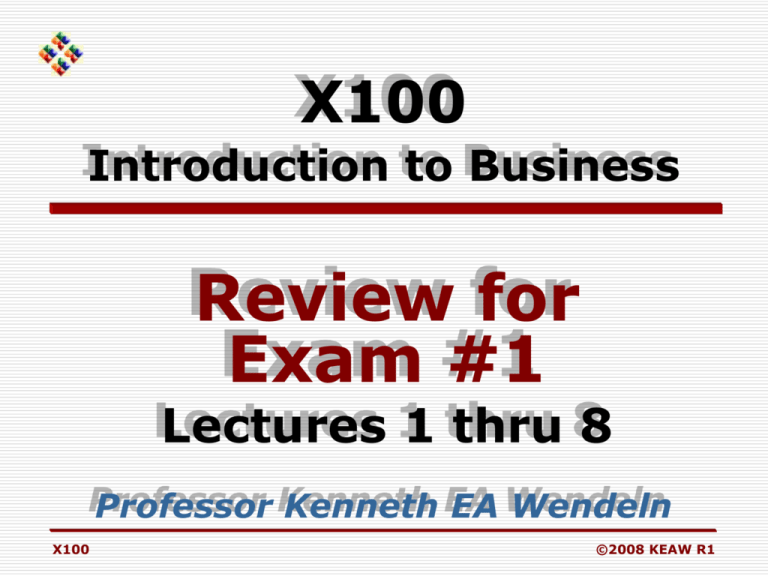
X100 Introduction to Business Review for Exam #1 Lectures 1 thru 8 Professor Kenneth EA Wendeln X100 ©2008 KEAW R1 Business: a Definition The organized effort of individuals & organizations To produce & sell…. for a profit Goods and services to customers That satisfy a society’s needs X100 Review for Exam #1 R1-2 Fundamental Business Resources Business Human Resources Informational Resources Material Resources Financial Resources Goods & Services Business must effectively combine all four resources to be successful X100 Review for Exam #1 R1-3 Types of Economic Systems Capitalism Socialism Communism Adam Smith – Professed aims – Karl Marx – Individuals - Government – Government – Market Economy – Command Economy – Command Economy – Mixed Economy – Visible Socialism – Communism – ‘laissez faire’ economy where society’s interest best served when individuals in that society are allowed to pursue own best interest’. own and operate majority of businesses that provide goods and services & have right to own & sell private property. businesses & individuals decide what to produce & buy. Market determines the quantity sold and prices. the US economy is a ‘modified capitalist’ or ‘free enterprise’ system with some government participation. X100 equitable distribution of income, elimination of poverty, distribution of social services based on need, eliminate economic waste. owns & controls key industries. Private ownership of smaller businesses may be permitted. government decides what will be produced, how it will be produced, who gets what is produced and the price. is present in many democratic governments, the most notable with a high degree of socialism include Sweden, Finland and India. Review for Exam #1 ‘classless society’, where individuals contribute based on their capabilities and receive benefits based on their needs. owns almost all of the economic resources. Practice a strictly controlled type of socialism. where emphasis is placed on production of goods that the government needs rather than on products consumers might want. has dwindled with breakup of the Soviet Union & economic reforms in China. North Korea & Cuba are the best remaining examples. R1-4 Key Features of the U.S. ‘Free Enterprise’ System System of business in which the individuals are free to decide what to produce, how to produce it and what to sell it for. Consumers’ freedom of choice – to allocate their own resources and spend their own money as they please Private ownership of land and real property – by individuals and businesses as governed by laws & covenants Competition – among businesses for the consumers’ dollars Supply & Demand – determined by consumer demand, availability, prices and market forces Circular Flow – of money for labor, resources & capital in exchange for goods & services Business Cycles – driven by economic growth & contraction $$ Profit Motive $$ For reinvestment & reward to investors X100 Review for Exam #1 R1-5 Circular Flow of Resources in ‘Free Enterprise’ System Taxes Services Consumer Spending Goods & Services X100 Resources US & Local Governments Products Households Consumers Govt Spend Income Govt Spend Resource markets Resources Labor & Capital Product markets Review for Exam #1 Resources Labor & Capital Wages Rent & Interest Taxes Services Businesses Sales Revenue Goods & Services R1-6 Types of Competition Competition - the rivalry among businesses for sales to potential customers Pure Competition – many buyers & many sellers Buyers and sellers must accept going price Monopolistic Competition – many buyers & relatively large number of sellers Businesses compete with product differentiation Oligopoly – market or industry with few sellers Each seller has considerable price control Monopoly – market or industry with only one seller Business with monopoly has complete control over price Natural monopoly – requiring huge capital investment Legal monopoly – with a patent, copyright or trademark © ™ X100 Review for Exam #1 R1-7 Principle of a Nation’s ‘Comparative Advantage’ Nations engage in international trade – because they own resources that enable a nation to produce some goods better & more efficiently than other nations In the past, primary sources of comparative advantage were better access to: Lower cost Labor Markets Financial Markets Technology Natural Resources Geographic Areas With ‘Globalization’ these sources of advantage are becoming less important X100 Review for Exam #1 R1-8 Artificial Restrictions on International Trade Tariff Barriers Import duty (or tariff) – tax that is levied on products entering the country. Raises the price. Dumping – exportation of large quantities of products at a price lower than same product in home market. Drives down the price. Non-tariff Barriers X100 Embargo – complete halt to trading of a product. Often used as a political weapon. Import quota – limits the amount that may be imported. Foreign Exchange control – limits amount of foreign currency that can be purchased. Has effect of limiting imports. Currency devaluation – reduction of the value of nation’s currency. Increases cost of foreign sourced goods. Bureaucratic ‘Red Tape’ – frustrates trade. Review for Exam #1 R1-9 Methods of Entering International Business Low High Degree of Control over Business Trade Arrangements 1. Trading Companies 2. Exporting & Importing 3. Counter Trade Int’l Contractual Agreements 4. Foreign Licensing 5. Franchising International Direct Investments 8. Joint Ventures 9. Totally Owned Facilities 6. Strategic Alliances 7. Production Agreements • Acquisitions • Subsidiaries • Overseas Divisions 10.Multinational Companies Degree of Financial Risk Low High More control usually means more financial risk X100 Review for Exam #1 R1-10 Globalization . . . . . . In Summary The world is ‘getting smaller’ with increasing int’l trade as: 1. ‘Comparative advantage’ is becoming less & less important 2. Significant reductions in trade tariffs & barriers – encouraged by GATT & WTO 3. Expansion of International Economic Communities – eg NAFTA, EU . . . Globalization is a reality today – International trade has tripled since WWII & now accounts for 21% of global income X100 Review for Exam #1 R1-11 Forms of Business Ownership In the United States, an owner can select from a variety of specific forms of business ownership. The form of ownership that is selected affects: 1. 2. 3. 4. 5. Legal charter & documents needed Regulatory & reporting requirements Financial resources available Owners’ liability & risk of losses Taxes - liabilities & benefits affecting the business affecting the owners (shareholders, partners, or members) 6. Length of life 7. Transfer of ownership 8. Ease of termination X100 Review for Exam #1 R1-12 General Categories of Business Ownership 1. Sole Proprietorship 2. Partnership General Partnership Limited Partnership Limited Liability Partnership or ‘LLP’ 3. Corporation ‘C’ Conventional Corporation ‘S’ Corporation 4. - Limited Liability Company The different forms have evolved in response to the specific needs of business people. X100 Review for Exam #1 R1-13 Relative Business Ownership in the US in 2004-2005 Number of Tax Returns Business Revenues Corporations 5.1 M Corporations 20.0% Partnerships 2.1 M 8.4% Partnerships Non-Farm Sole Proprietorships 18.3 M 71.6% $2,569 B $19,308 B 84.4% 11.2% $1,017 B 4.4% Source: US Census Bureau, Statistical Abstract of the United States, 2004-05, www.census.gov X100 Review for Exam #1 R1-14 ‘Informal Forms’ - Summary Sole Proprietorships & Partnerships Forms of Ownership IRS Income & FICA Taxes Sole Proprietorships Partnerships • General An ‘extension’ of the individual s involved: • Easy to form - no legal charter required • UNLIMITED personal liability for the business • Single taxation at personal tax rates X100 Review for Exam #1 R1-15 ‘Formal Forms’ of Partnerships Limited & Limited Liability Partnerships Forms of Ownership IRS Income & FICA Taxes STATE Legal Charters http://www.in.gov/sos... Sole Proprietorships Partnerships • General • Limited • ‘LLP’ • Limited Partnerships & Limited Liability Partnerships (LLP’s) offer some ‘limited’ liability • Must have a ‘legal charter’ with the state • Single Taxation at personal tax rates X100 Review for Exam #1 R1-16 Entities Governing Forms of Business Ownership Forms of Ownership IRS Income & FICA Taxes STATE Legal Charters SEC Securities Regulations Sole Proprietorships Partnerships • General http://www.IN.gov/sos/ • Limited • ‘LLP’ Limited Liability Companies • Multi-member • Single-member Corporations http://www.sec.gov/ • Publicly • ‘C’ Corps Traded • ‘S’ Corps X100 Review for Exam #1 R1-17 Types of Corporations 1. ‘C’ Corporations ‘Conventional’ or ‘C’ Corp Results in double taxation ‘C’ Corp pays corporate income taxes ‘C’ Corp pays dividends to shareholders who may also be taxed on those dividends 2. ‘S’ Corporations A tax elective (subchapter ‘S’) for a conventional corporation that may be taxed once as a passthrough to each of the shareholders A corporation may apply to IRS for ‘S’ tax status if certain criteria are met: 1. 2. 3. 4. 5. 6. X100 No more than 100 stockholders allowed All stockholders must agree to the ‘S’ election Must be a domestic corporation Only one class of stock allowed Stockholders must be individuals, estates & certain trusts No nonresident alien stockholders Review for Exam #1 R1-18 Hierarchy of Corporate Structure Incorporators 1. Corporate Charter 2. Articles of Incorporation 3. Organizational Meeting 4. Elect the initial Board of Directors Owners/Stockholders (elect Board of Directors) Board of Directors (hire the Officers) Officers (set corporate objectives & select Managers) Managers (supervise Employees/Associates) Employees/Associates X100 Review for Exam #1 R1-19 Limited Liability Company LLC’s are unincorporated legal entities created under state law – providing the benefits of both liability protection & single pass-thru taxation. Relatively new business form – all 50 states and District of Columbia now have laws authorizing the formation and operation of LLCs within their borders. LLCs offer owners liability protection – intent of state laws is to allow the formation of entities that are legally more similar to corporations than partnerships. LLC owners are referred to as ‘members’ – rather than shareholders or partners. Earning (& losses) allocated to the members – taxed as a corporation, partnership, or sole proprietorship. LLCs are NOT corporations & NOT partnerships X100 Review for Exam #1 R1-20 Types of Limited Liability Companies 1. Single-member LLCs Recognized on most states, including Indiana Pass through taxation - same as sole proprietor Recognized in all states Limited liability for all LLC members Can be treated either as a Partnership or a Corporation for federal income tax purposes 2. Multi-member LLCs Member-managed LLCs LLC statute and operating agreement determine voting rights Any member has authority to legally bind the LLC in the ordinary course of business Manager-managed LLCs X100 Non-manager LLC members have very limited management rights similar to stockholders Review for Exam #1 R1-21 Summary & Comparison Forms of Business Ownership Sole Best Neutral Worst Proprietorships Partnerships General Corporations Limited & LLP ‘S’ Corp Conventional LLCs ‘C’ Corp 1 2 3 4 5 Business Formation none Partnership Agreement State State State State Regulations, none none State State State & SEC State Liability – Risk of Loss Unlimited personal Unlimited personal Unlimited & Limited Limited to investment Limited to investment Limited to investment Access to Fin’l Resources Personal debt Partners + debt Partners + debt Debt & equity Debt & equity Debt & equity Income Taxation Income once Income once Income once Income once Corp Income + Dividends 6 Continuity of Business Life Death of sole proprietor Death/ withdrawal of a partner Death/ withdrawal of G partner Perpetual life or Agreement Perpetual life or Agreement Based on agreement 7 8 Ease of Transfer of Ownership Limited – asset sale Partners’ Agreement Partners’ Agreement Stock sale, restrictions Stock sale Limited Management & Responsibilities Proprietor manages All Partners manage GP manages Hired mgmt Hired mgmt Hired or self- mgmt Reporting, Secrecy X100 Review for Exam #1 Choice of Taxation Method R1-22 Evolution of a Business Call Tracy for Tennis Lessons Sole Proprietorship for simplicity ö Tracy’s ö Tennis Pro Shop and Lessons Multi-member LLC or ‘S’ Corp for investors & single taxation Single Member LLC for limited liability ö Tracy ö ™ Tennis Center and Pro Shop ‘C’ Corp for IPO & stock trading X100 ö Tracy ö ™ Entertainment and Tennis Centers Review for Exam #1 R1-23 Small Business and Trends One that is independently owned & operated for profit – and is not dominant in its field Not large – of the 23 million businesses in the US, only 17,000 employ more than 500 workers – enough to be considered large High growth – during the past decade, the number of small businesses in the US has increased nearly 50% Part-time small business – 5 times growth in recent years and now account for one-third of all small businesses Importance in providing jobs – small businesses provide over 50% of the jobs in the US Technical Innovation – more than 50% of the major technological advances of the 20th century originated with individual inventors and small companies Small business is very important to the US economy - and has helped to fuel its growth X100 Review for Exam #1 R1-24 Small Business Administration SBA ‘Smallness’ Guidelines Service Industries % of Small Businesses 1. Services < $2.5m to $22m annual receipts Distribution Industries 2. Retailing Service < $6.5m annual receipts 48% 3. Wholesale Trade < 100 employees Production Industries Distribution 33% 4. Manufacturing < 500 to 1500 employees 5. General & Heavy Construction < $31m annual receipts Production 19% 6. Special Trade Construction < $13m annual receipts X100 Review for Exam #1 R1-25 Pros & Cons of Small Businesses Advantages Disadvantages 1. Flexibility 1. Risk of failure Ability to adapt to change 2. Independence You are your own boss 3. Service Closer to the customer 4. Simplified Business form Record keeping 5. Specialization X100 2 out of 3 close their doors within the first 5 years 2. Limited potential Based on technical and business skills of the owner 3. Limited ability to raise capital 67% begin with <$10,000 4. Little ‘power’ With big customers With major vendors Review for Exam #1 R1-26 Characteristics of a Successful Entrepreneur 1. Vision 2. High energy level 3. Self-confidence 4. Optimism 5. Creativity 6. Tolerance for uncertainty 7. Tolerance for failure X100 Review for Exam #1 R1-27 Likelihood of Success “Statistically, over 70% of new businesses can be expected to fail within their first five years.” Improve your odds & likelihood of success: Good business plan Good advice (eg the SBA) Franchising X100 Review for Exam #1 R1-28 Developing a Business Plan A carefully constructed guide for the person starting the business . . . . also serves as a concise document for potential investors. 1. Introduction 2. Executive Summary 3. Benefits to Community 4. Company & Industry 5. Management Team 6. Operations Plan 7. Labor Force 8. Marketing Plan 9. Financial Plan 10. Exit Strategy 11. Assessment of Risk 12. Appendix Alford Media Video For more help from the SBA: http://www.sba.gov/smallbusinessplanner/index.html X100 Review for Exam #1 R1-29 Small Business Administration “America’s small business resource” established in 1953 to ‘aid, counsel, assist and protect the interests of small business’ Financial Assistance – Loans via private lenders guaranteed by the SBA SBA guaranteed $19.5 billion in loans in 2006 Current maximum is $1 million via lenders, 85% up to $150,000 Assist with Government Procurement – Small business ‘set-aside’ programs Supplementary programs for minority & female owned businesses Training and Consulting Assistance – SCORE – Service Corps of Retired Executives ACE – Active Corps of Executives SBI – Small Business Institute http://www.sba.gov Encourage Legislation & Provide Information X100 Review for Exam #1 R1-30 Franchising An agreement between a Franchisor & a Franchisee, to market, sell or license products, services or concepts. Franchisee pays fees to the Franchisor. Franchisor Sells franchise to Franchisee Gains fast & selective distribution with minimal costs Opportunity to start a business with limited capital Collects upfront and ongoing fees from the franchisee Makes use of proven concepts & the business experience of the others Benefits from the investments made by a highly motivated franchisee Benefits from brand names and national/local promotional activities Retains a great deal of control over the brand name, product & service One-time franchise fees and continuing royalties can be a financial burden X100 Review for Exam #1 R1-31 Still Operating after Franchise Success vs Independent Businesses Franchises 1 year Independents 5 years 90% 10 years Source: US Department Of Commerce X100 0 20 40 Review for Exam #1 60 80 100% R1-32 The Five-Step Management Process Management - is the process of leading and coordinating people (along with other resources) to achieve the organization’s goals & objectives. Planning • Strategic • • • • Tactical Operational Contingency Goal Setting Organizing • Resources • Activities • Structure • Chain of Command Directing Controlling • Motivating • Delegating • Prioritizing • Measuring • Corrective action • Leading • Set standards Review and modify Managements’ Focus – ‘Getting the Job Done’ X100 Review for Exam #1 R1-33 Planning Planning – establishing the organization’s mission, goals & objectives and developing strategies & plans to achieve them Strategic planning – the fundamental longer- term strategies and key GOALS of the organization Tactical planning – specific action-oriented OBJECTIVES related to specific functions & departments Operational planning – very short-term (weekly & daily) plans, BUDGETS & performance expectations Contingency planning – ‘WHAT-IF’ plans that address possible ‘downside & upside’ economic & business scenarios X100 Review for Exam #1 R1-34 The Organizing Process Defining the Jobs Major FUNCTIONS and related TASKS Organize into WORK ASSIGNMENTS Departmentalization Group jobs into manageable units - ‘DEPARTMENTS’ or ‘SECTIONS’ Form by major FUNCTION, PRODUCT, LOCATION, hybrid or matrix Delegation Distribute RESPONSIBILITY & AUTHORITY within the organization Span of management WIDE or NARROW – number of subordinates reporting to each manager ORGANIZATIONAL HEIGHT – layers or levels of management Chain of command LINE positions – with direct authority STAFF positions – support positions Organiz ations Video Organizing resources, activities and structure X100 Review for Exam #1 R1-35 Corporate Organization Levels of Management Board of Directors Hires the officers. CENTRALIZED ORGANIZATION Management systematically works to concentrate authority at the UPPER levels of the organization Officers & Top Management Set corporate goals & select managers. Top Mgm't Video Middle Management Middle Mgm't Video Implements strategy, develops tactical & operational plans & objectives. Supervises first-line managers. DECENTRALIZED ORGANIZATION Management consciously attempts to spread authority widely in the LOWER levels of the organization Delegation First-Line Management Coordinates & supervises activities of employees/associates. Employees/Associates X100 Review for Exam #1 R1-36 Span of Management 1 President President 3 Flat Organization - W i d e S p a n Many direct reports 4 5 Tall Organization -Narrow SpanFew direct reports ‘Organizational Height’ refers to the number of layers or levels of management in an organization X100 Review for Exam #1 R1-37 Directing Leading & Motivating … Effective managers possess certain skills … … and are able to use these skills in a number of managerial roles. Management SKILLS 1. Technical Skills - 1. Decision Roles - • Knows the skills needed to accomplish a job or specialized activity 2. Conceptual Skills – • Ability to think in abstract ‘holistic’ terms • Vision – the ‘big picture’ 3. Interpersonal Skills • Lead & motivate - deal effectively with people X100 Managerial ROLES • Effective management decision making and delegation 2. Information Roles – • Gathering information • Disseminating and providing information 3. Interpersonal Roles • Communicating & dealing with people Review for Exam #1 R1-38 Leadership Styles and Traits Subordinate-centered leadership Boss-centered leadership Area of FREEDOM for subordinates Use of AUTHORITY by manager Manager MAKES the decision & announces it Manager ‘SELLS’ the Decision Manager PRESENTS decision & invites questions Autocratic Bureaucratic Manager presents ‘TENTATIVE’ decision – but subject to change based on input from subordinates Manager presents problem, gets SUGGESTIONS, and makes the final decision Participative Democratic Manager permits SUBORDINATES to function within the LIMITS or GUIDELINES defined by superior Free rein Laissez-faire No single leadership trait is effective in all situations. Use a style most appropriate to situation & employees. Adapted from HBR, How to Choose a Leadership Pattern, 6/73 X100 Review for Exam #1 R1-39 Steps in the Delegation Process To be successful in an organization, a manager must learn to delegate. No one person can do everything alone. Manager 1. Assign Responsibility The DUTY to do a job or perform a task. 2. Grant Authority The POWER to accomplish an assigned job or task. 3. Assign accountability The OBLIGATION of a worker to accomplish an assigned job or task. Worker X100 Review for Exam #1 R1-40 The Control Function Controlling - is the process of evaluating and regulating ongoing activities to ensure that goals & objectives are set & achieved. Setting Goals & Objectives Measuring Actual Performance Taking Corrective Action Evaluating performance to Goals & Objectives X100 Review for Exam #1 R1-41 Review & Modify Review & modify the steps in the process periodically (usually annually) … or when shortfalls or key economic or competitive events occur. Planning • Strategic • • • • Tactical Operational Contingency Goal Setting Organizing • Resources • Activities • Structure • Chain of Command Directing Controlling • Motivating • Delegating • Prioritizing • Measuring • Corrective action • Leading • Set standards Review and modify X100 Review for Exam #1 R1-42 Motivation – Maslow’s Hierarchy of Needs A NEED is a personal requirement. Maslow’s Hierarchy provides a useful way of viewing employee motivation. 5. 4. 3. 2. 1. X100 Selfactualization needs Esteem needs The need to grow & develop – and to become all that we are capable of being The need for respect, recognition - sense of our own accomplishment & worth Social needs Our requirements for love and affection & a sense of well-being Safety needs The things we require for physical & emotional security Physiological needs The things we need for survival Review for Exam #1 R1-43 Dr. Phil’s - Hierarchy of Needs & Personal Critical Choices Lower needs must be fulfilled before the next higher need becomes relevant. External vs internal ‘choices’. 7. 6. 5. Selfactualization needs 4. 3. 2. 1. Spiritual Fulfillment Vision beyond personal interest Intellectual Fulfillment The pursuit of knowledge or answers Self-Expression Self-Esteem needs Love needs Security needs ‘Uniquely ours’ – mark on the world ‘Self-validation’ – from the inside . . . . . . or the outside from someone else Either have it . . . . . .or driven to find it Basis for physical & emotional security acceptance & belonging Life itself must be protected Our most basic need Survival needs X100 Adapted from: Self Matters by Dr. Phil McGraw Review for Exam #1 R1-44 Motivation – Vroom’s Expectancy Theory Vroom’s theory is based on the idea that motivation depends on: 1st - how much people want something . . . AND 2nd - on how likely they think they are to get it. Does the person want the outcome ? No Not Motivated X100 Yes Does the person think that the outcome is likely ? Yes Motivated !!! No Not Motivated Review for Exam #1 R1-45 Herzberg’s Motivation – Hygiene Theory Hygiene Factors – eliminate job dissatisfaction. Motivation Factors – increase job satisfaction. Motivators • Achievement • Supervision • • • • • • • • • • • • Extremely Satisfied X100 Hygiene Factors Recognition Work itself Responsibility Advancement Growth Company Policy Relationships Working Conditions Salary Personal life Status Security Neutral No Satisfaction – No Dissatisfaction Review for Exam #1 DisSatisfied R1-46 Classical ‘Six-Step Action-Oriented’ Decision Making Process Step 1. RECOGNIZE the need - to make a decision Step 2. LIST - Generate alternatives Step 3. RANK - Assess the alternatives Step 4. SELECT - Choose among the alternatives Step 5. Step 6 6.. X100 IMPLEMENT the chosen alternative LEARN from feedback & consequences Review for Exam #1 R1-47 ‘Cognitive Biases’ Leading to Systematic Errors Errors that managers make over and over again that result in poor decision making - examples: 1. Prior hypothesis bias Tendency to base decisions on strong prior beliefs even if evidence shows that those beliefs are wrong. 2. Representativeness bias Tendency to generalize inappropriately from a small sample or from a single vivid event or episode. Cognitive Biases » Errors 3. Illusion of control Tendency to overestimate one’s own ability to control activities and events. 4. Escalating commitment Tendency to commit additional resources to a project even if evidence shows that the project is failing. X100 Review for Exam #1 Be Aware of Your Biases ! R1-48 Group Decision Making Group decision making is usually superior to individual decision making in many respects: 1. Group are less likely to fall victim to the cognitive biases & systematic errors. 2. Draws on combined skills, competencies and knowledge of the group. 3. Ability to process more information and correct each others’ errors. 4. Improves ability to generate more feasible alternatives and make better decisions. 5. Increases the probability that the decision will be implemented successfully. Beware of the perils of ‘Groupthink’: A pattern of faulty and biased decision making that occurs in groups whose members strive for agreement among themselves - at the expense of accurately assessing information relevant to a decision. X100 Review for Exam #1 R1-49 Types of Formal Teams Management Teams Consisting mainly of managers from various functions like sales & production. Coordinates work among the other types of teams. Quality Circles In danger of extinctions, this type, typically made up of workers & supervisors, meets intermittently to air workplace problems & solve quality issues. Work Teams Permanent Project Teams Virtual Teams A characteristic of this new type of work team: members talk by computer, flying in and out as needed, and take turns as the leader. X100 Work teams do just that – the daily work. Becoming increasingly popular. When empowered, the can become self-managed teams. Temporary Review for Exam #1 Problem-solving teams comprised of knowledge workers who gather and solve a specific problem or meet a specific goal – & then disband. R1-50 Group Cohesiveness and Productivity X100 COHESIVENESS of the Group Low High High Strong increase in productivity Moderate increase in productivity Low ALIGNMENT of Group & Organizational Goals Cohesiveness is the degree to which members are attracted to one another and share the group’s goals. Decrease in productivity No significant effect on productivity Review for Exam #1 R1-51 Conflict and Group Performance Low Level of Conflict High High Level of Group Performance Low Level of Conflict Low or none Optimal High Type of Conflict Dysfunctional Functional Dysfunctional Group’s Internal Characteristics Stagnant, Apathetic Unresponsive to change & new ideas Viable Self-critical Innovative Disruptive Chaotic Uncooperative Low High Low Group Performance X100 Review for Exam #1 R1-52 Personnel Law Employment-at-Will Doctrine Collective Bargaining (Unions) Individuals’ Rights Workplace Safety & Security Employment Discrimination X100 Review for Exam #1 R1-53 Employment-at-Will Doctrine An employer can hire and fire an employee . . . . at ANY time . . . . for ANY reason . . . or NO reason. An employee can QUIT. . . at any time . . . without notice. Basic doctrine may be modified by: 1. Employment contracts (written & implied) 2. Union contracts 3. Applicable Federal & State laws and regulations X100 Review for Exam #1 R1-54 Collective Bargaining National Labor Relations Act (1935) – Establishes a collective bargaining process & the NLRB Labor-Management Relations Act (1947) – Also known as the Taft-Hartley Act Provides a balance between union power and management power Worker Adjustment and Retraining Notification (1988) – Also known as the WARN Act Requires employer to give employees 60 days notice regarding plant closure or layoff of 50 or more employees X100 Review for Exam #1 R1-55 Individuals’ Rights Fair Labor Standards Act (1935) – Establishes a minimum wage & an overtime pay rate for employees working more than 40 hours per week Equal Pay Act (1963) – Specifies that men and women who do equal jobs must be paid the same wage Family and Medical Leave Act (1993) – Affects only organizations with 50 or more employees Provides up to 12 weeks of leave without pay upon the birth (or adoption) of an employee’s child Or if an employee, employee’s child, spouse or parent is seriously ill X100 Review for Exam #1 R1-56 Workplace Safety & Security Occupational Safety and Health Act (1970) – OSHA regulates the degree to which employees can be exposed to hazardous substances Specifies the safety equipment that the employer must provide Employment Retirement Income Security Act (1974) – ERISA regulates company retirement programs Provides a a federal insurance program for retirement plans that go bankrupt X100 Review for Exam #1 R1-57 Employment Discrimination Title VII of the Civil Rights Act (1964) – Outlaws discrimination in employment practices based on sex, race, color, religion or national origin Age Discrimination in Employment Act (1967) ADEA outlaws personnel practices that discriminate against people aged 40 and older 1986 amendment eliminated a mandatory retirement age Americans with Disabilities Act (1990) – ADA prohibits discrimination against qualified individuals with disabilities in all employment practices (job application procedures, hiring, firing, advancement, compensation, training and terms of employment) Civil Rights Act (1991) – Facilitates employees’ suing employers for sexual discrimination and collecting punitive damages X100 Review for Exam #1 R1-58 Ethical Behavior in Organizations Ethics: is the study of right and wrong – and of the morality of choices individuals make. Business Ethics: is the motivating force of business behavior (often seen as impositions & constraints). Level of Business Ethical Behavior Individual Standards & Values + Social Factors & Influences + Opportunity Codes & Compliance = Ethical/Unethical Choices in Business X100 Review for Exam #1 R1-59 Snapshot of an Ethical Organization An ethical company: Treats all stakeholders adequately & fairly Consistently makes fairness the first priority Expects individual, rather than vaguely collective, accountability Defines objectives & goals that all members value Portrays a clear vision of integrity, exemplified by management Demands & reward integrity at all times & in all situations Your role: If you feel good about the company you should act in harmony with the firm & its values. If you feel that the organization is wanting in ethics you need to make some choices. The first choice is to act ethically yourself !!!! X100 Review for Exam #1 R1-60 Pyramid & Views of Social Responsibility Economic Model Society will benefit most when business is left alone to market products that society needs – profit focus Socio-Economic Model Voluntary Responsibilities Business should emphasize not only profits, but also the impact of its decisions on society Being a ‘good corporate citizen’ – Contributing to the community & quality of life Ethical Responsibilities Being ‘ethical’: Doing what is right, just & fair; Avoiding harm Legal Responsibilities Obeying the law (society’s codification of right & wrong) Playing by the ‘rules of the game’ Economic Responsibilities Being profitable X100 Review for Exam #1 Source: ‘The Pyramid of Corporate Social Responsibility’, Business Horizons by Carroll, IU R1-61 General Criteria for Evaluating Courses of Action Is the possible course of action: Legal ? Ethical ? Economical ? Practical ? X100 Review for Exam #1 R1-62 Deal & Kennedy’s Corporate ‘Cultural Model’ Corporate culture - the inner rites, rituals and values of a firm RISK FEEDBACK & REWARD Rapid Low Work-Hard, Play-Hard Tough-Guy ‘Macho’ Culture • • • • Stress comes from quantity of work versus uncertainty High speed action leads to high speed recreation Examples: Software Companies, Restaurants Process Culture • • Slow High • • • • Stress comes from high risk & potential loss/gain of reward Focus on the present … rather than the longer term future Examples: Surgeons, Police, Sports Bet-the-Company Culture Low stress, plodding work, comfort & • security. Stress comes from internal politics & stupidity of the system • Development of bureaucracies & ways to maintain the status quo. Focus on security of the past & the future • Examples: Banks, Insurance Companies Stress coming from high risk and delays before knowing if actions have paid off The long view is taken, but then much work is put into making sure things happen as planned. Examples: Aircraft Manufacturers, Oil Companies. Source: Deal & Kennedy, ‘Corporate Cultures’, 2000 reprinted. ChangingMinds.org X100 Review for Exam #1 R1-63 Individual Characteristics & ‘Types of Corporate Culture’ High Networked Culture Communal Culture • • • • Sociability • • • • You consider yourself passionate Strong need to identify with something bigger than yourself You enjoy being in teams Prepared to make sacrifices for the greater good Fragmented Culture Mercenary Culture • • • • • Low Extrovert energized by relationships Tolerant of ambiguities & have low needs for structure Can spot politics and act to stop negative politics Consider yourself easygoing, affable and loyal to others Are a reflective & self-contained introvert Have a high autonomy drive and strong desire to work independently Have a strong sense of self Consider yourself analytical rather than intuitive Low • • • Goal-oriented and have an obsessive desire to complete tasks Thrive on competitive energy Keep ‘relationships’ out of work – develop them only to achieve your goals Keep things clear cut and see the world in black and white Solidarity - Unity High Source: ‘Types of Corporate Culture’ from The Character of the Corporation by Goffee & Jones X100 Review for Exam #1 R1-64 X100 Review for Exam #1 R1-65



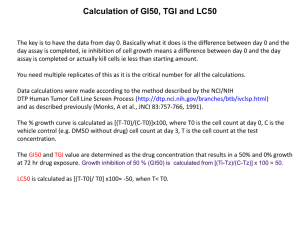
![1. Find the pH of 0.1 M HClO4 This is a strong acid, so [H ] = 0.1 M](http://s3.studylib.net/store/data/008121755_1-338138652fc42091377fe33aaddd7c71-300x300.png)
